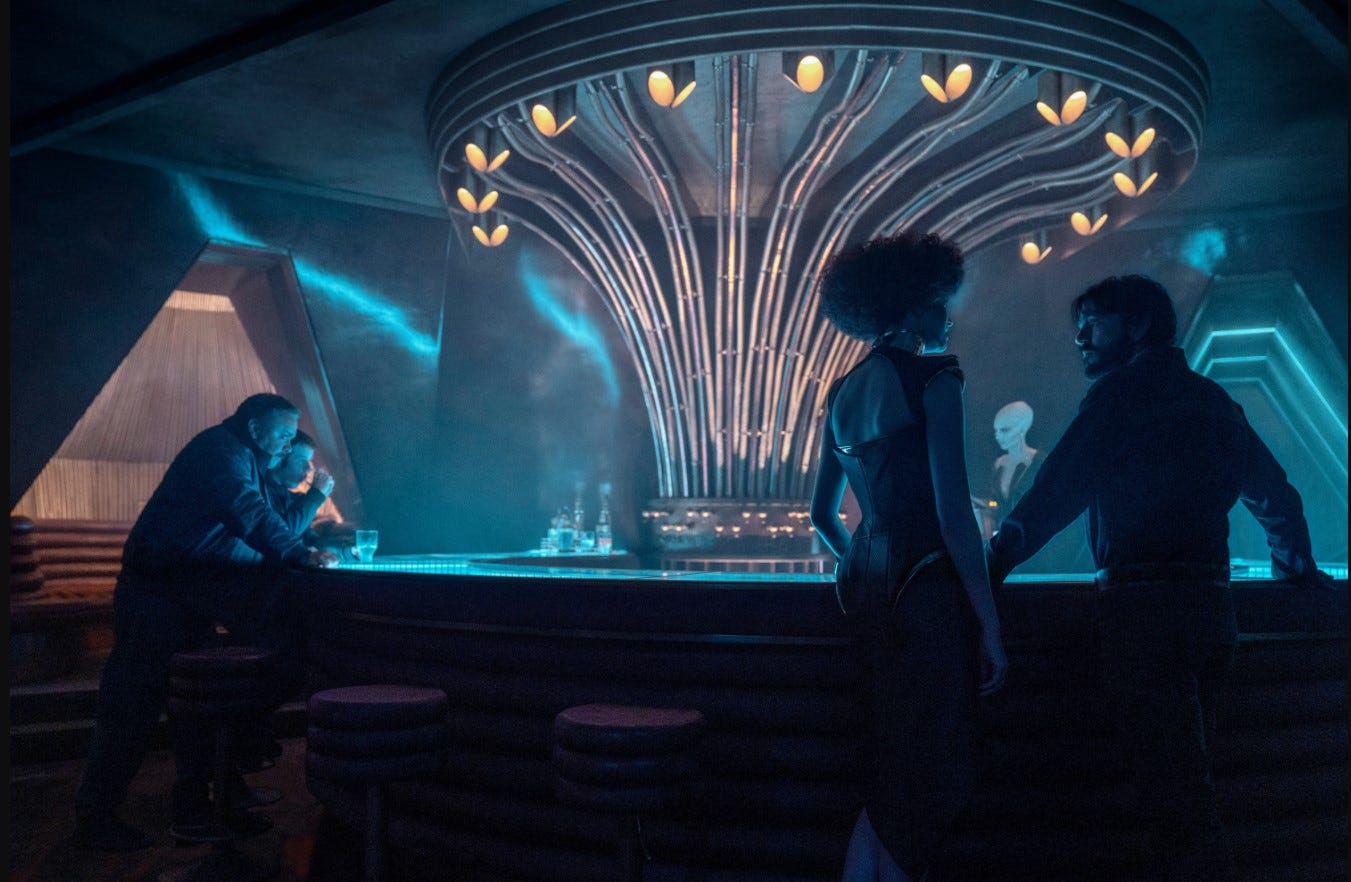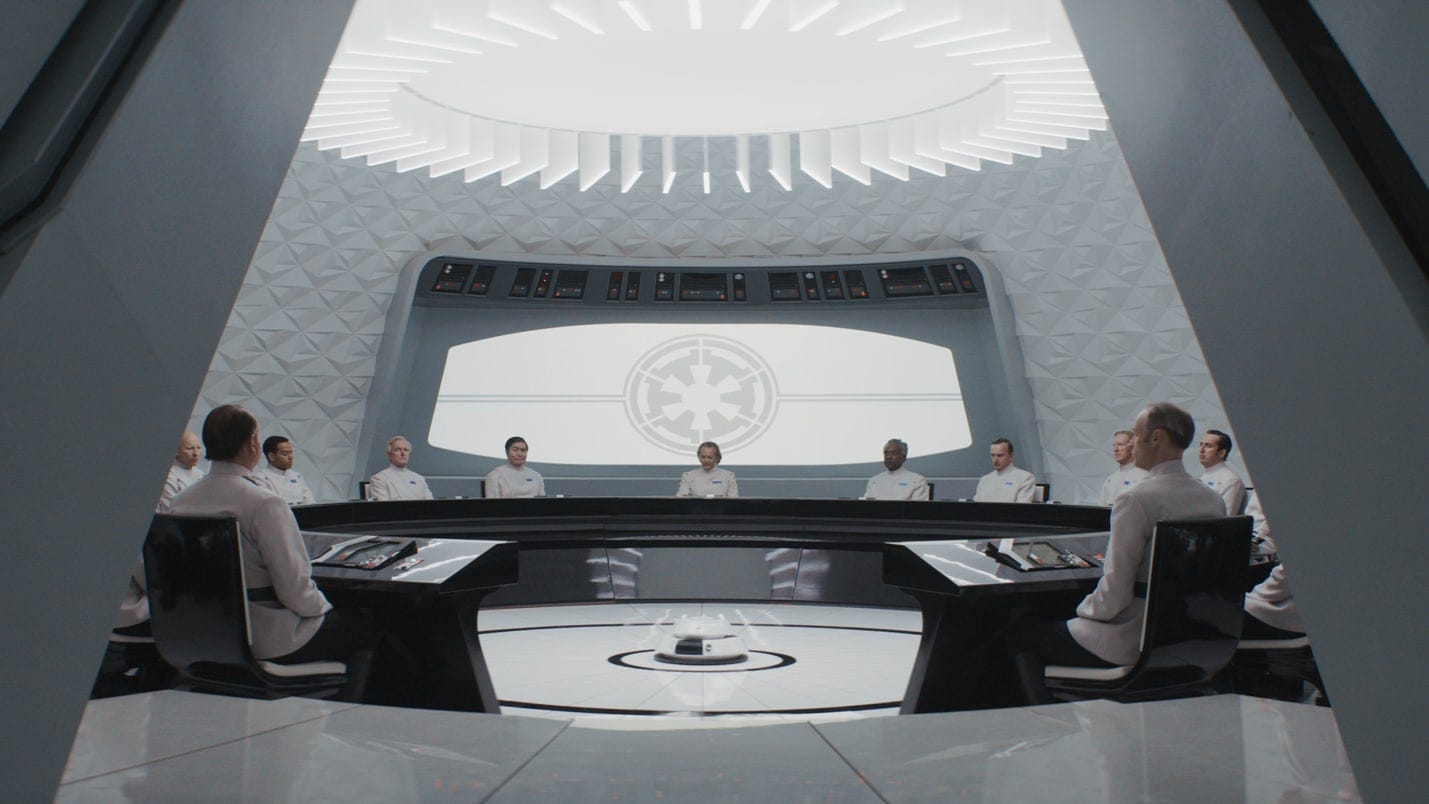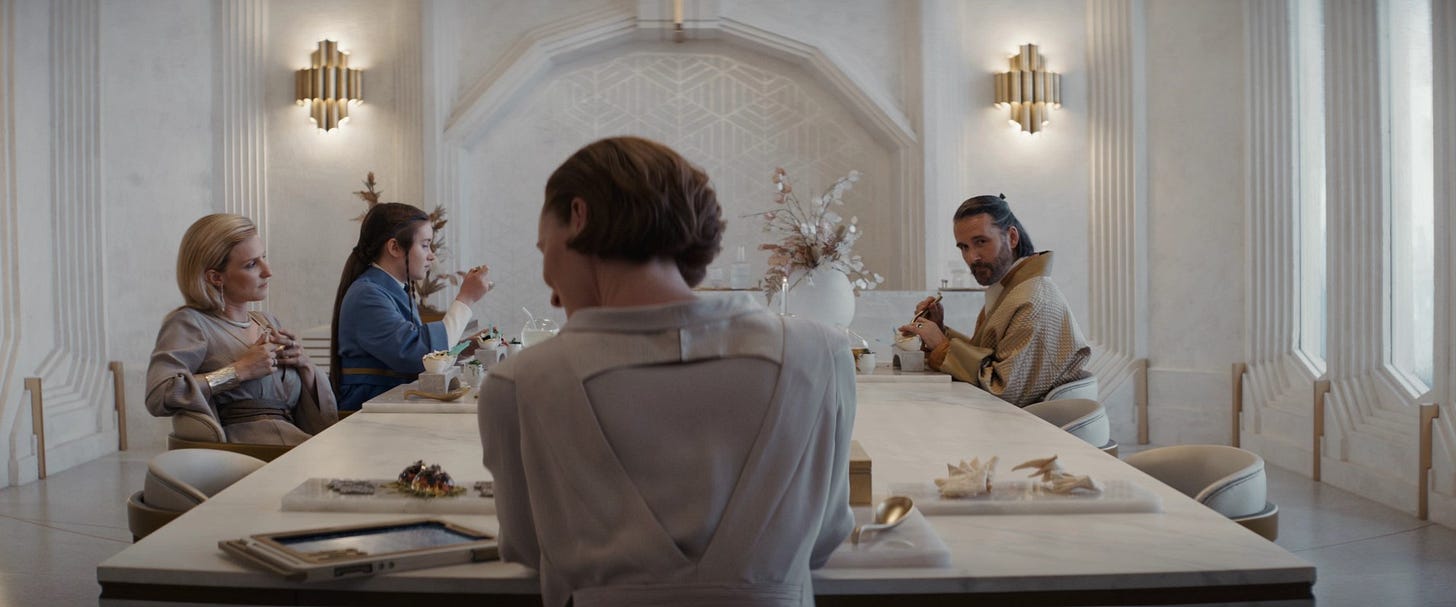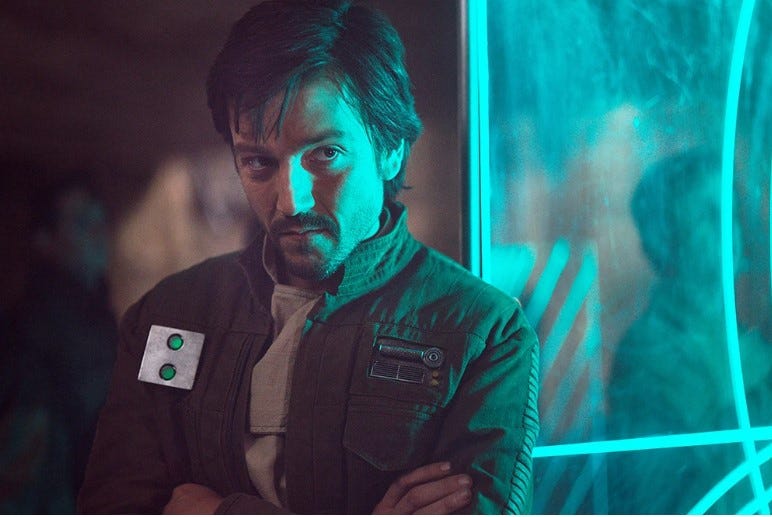Sharing Dreams with Ghosts
why Star Wars is only good when it's self aware
God fucking help me, I’m going to talk about Star Wars on the internet. What hell hath I wrought?
I’m not going to go through the exhausting narrative of my childhood and what Star Wars was or wasn’t to me. Every fanboy on the internet has done this and it adds no value to anyone’s argument.
Suffice it to say, I love Star Wars when it recognizes itself for what it is. A convoluted mess of fantasy tropes force-fed into a cyberpunk aesthetic that almost always focuses more on gimmicks, objects, and places more than characters, themes, or alleged political subtext. Generally speaking, Star Wars always has been and always will be, pretty fucking dumb. The least interesting aspects of Dune, Foundation, and Do Androids Dream of Electric Sheep? used as window dressing for a Joseph Campbell plugin that neither expands upon nor upends the standard conventions of adventure storytelling.
[Before we move forward, it really needs to be explicitly stated here that I do NOT consider Star Wars science fiction. At all. At least in Episodes I-IX, there’s little attention to detail in how the galaxy functions, no explanation as to the science of it all (just the opposite; we literally get an imaginary Force that explains away an entire occupation of magic users,) and the metaphors at hand are in reference to war, not technology or human advancement. Star Wars is wholly a work of fantasy, merely set in a world of laser beams and spaceships. The opening text of every film is literally, ‘A long long time ago, in a galaxy far, far away.’ It doesn’t get more fantasy-driven than that.]
And while this makes Episodes 1-6 perfectly good fun, it means that I’ve come to value all of them less the older I get. Even The Empire Strikes Back — which is now looked at as the gold standard for Star Wars — feels a bit meandering and stakeless in the context of the whole saga. There will be endless arguments about Disney’s take on Episodes 7-9, and I don’t have much more to add to that for now other than some lessons I want to use as evidence for my thesis today.
Which is this: Andor is such a perfect example of how great something as stupid as Star Wars can be when it's firing on all cylinders.
[Ooooh surprise, surprise. The Cinema Studies student is defending a piece of television that has multiple blatant references to Black Narcissus. V shocking, V academic.]
Yes, I’m late to the party.
The general consensus for a year now is that Andor is the best thing to happen to Star Wars in ages…At least, from anyone whose opinion I trust on these things. I’ve heard just as many SW fans on reddit say that it’s the worst thing ever. Which tells me all I need to know.
But still, I avoided this show like the plague for months.
Burnout isn’t even the right word. Burnout is how we describe the MCU’s formulaic approach to screenplays or DC’s halfhearted attempts at making us care about Batman once more. Burnout is for Netflix churning out the same slog every week and then having their algorithms bury the bodies as quickly as possible.
The feeling I’ve had with Star Wars is different. It’s closer to something akin to an abusive relationship. It’s masochistic, forcing myself to keep watching all this stuff just to ‘stay up to date.’ There are no more SW films on the immediate horizon and most of these streaming shows don’t seem to have a definitive end goal.
And, to be blunt, they’ve all sucked ass.
I’ve actively disliked every season of The Mandalorian to one extent or the other. Ripping off Lone Wolf & Cub and Throne of Blood only gets you a pass in my book for so long. It ultimately is still nothing more than a giant carrot of nostalgia for the Filoni dickriders out there who have no interest in getting out of their own way to let the story move forward. (See: the opening of season 2 where we get a great Jaws parallel episode, only to have it completely squashed at the end by reviving Boba Fett from the sarlacc’s small intestine.)
Obi-Wan truly feels like it was written by AI. There wasn’t a moment of that screenplay that wasn’t explicitly informed by memes and fanfiction. And I’m not one to have a meltdown over plot holes, but everything in that series actually makes the continuity between Episodes III and IV MORE confusing, not less.
The fans turning their back on The Book of Boba Fett doesn’t validate anything for me. Just like with Episode IX, the backlash isn’t based on anything related to the story or filmmaking itself, but rather the insecurities inherit within the fanbase. Rise of Skywalker’s rat-nested plot is a directly result of Twitter’s insane reaction to Episode VIII, and The Book of Boba Fett’s limp performance is a direct result of the fact that the titular character is a jobber who gets Wilhelm Screamed into fodder during a throwaway moment in Return of the Jedi. He’s only ever been held in reverence by the action figure collectors of old who have never once cared about anything other than the aesthetics of his armor.
Even once I finally booted up Endor a few weeks ago, I still had reservations. Namely in that it was a prequel series to a prequel movie about a secondary character who had little impact on the overall narrative of the 9 primary films’ main arcs. This can be both a good thing and a bad thing, and — given Star Wars’ track record — I assumed it would be the former.
Thankfully, even just the pilot episode assured me I was in safer hands than anyone else that had touched the franchise in 5 or 6 years. (S/O to RJ, our lord and savior in this time of wretched big budget films.)
Again, returning to Episodes IV-VI for a moment. What was the actual selling point of those films? The lore that reddit gushes over nowadays wasn’t present back then. Spielberg, De Palma, and Coppola explicitly threw every exposition dump in the trash [rightfully so] when Lucas brought them the first cut of A New Hope. Few names in any of the three films were true ‘stars’ at that time, in so much as audiences were going to come running to the theater just to see their shining faces. The premise alone was considered a sub-art, treated as another genre gimmick film in the same vain as Forbidden Planet.
It was always about visuals. Star Wars is literally nothing without its visual component. The first three films are heralded as watershed moments in special effects. Even the ridiculous text crawl at the beginning of every film was seen as a breakthrough. No one walked away from those movies heralding the commentary on the Vietcong or the character growth (I’d actually argue most fans have misread a LOT of how the characters grow from Episode IV onward, especially Luke.) But every single person who has seen Star Wars remembers the feeling the first time they saw the Death Star explode or the lightsaber ignite. Star Wars started out as more of a great gimmick than it did a great story, and therein lied the rub for many a decade.
This is both the greatest asset and the biggest obstacle for modern Star Wars stories. Writers like Dave Filoni mistakenly think the answer is more lightsabers and understanding how the Death Star works. He wants surface-level questions answered with retreaded topics — tried and true and riddled with dopamine. He and the redditors just want to know what Obi-Wan was doing on Tatooine for twenty years, not why he was doing it or how he felt about it. They want to see him fight Vader a dozen more times, even though we know nothing will come of it and it only makes them both look dumber by the time we get to Episode IV for the final showdown.
That’s not where Star Wars excels. It’s not interesting, it’s not entertaining, it’s not memorable, and it’s not, well….good. It’s the bare minimum and it’s horribly misguided. It’s what happens when fans dictate the story, rather than artists and writers and directors. And go figure, after ten years of fans telling Disney what to do, the Star Wars universe is now a convoluted mess of really, really bad stories that no one remembers.
You’ll repeatedly hear dorks like me say that The Last Jedi, Rogue One, and Andor are the only good things about Disney’s Star Wars. And to some extent, I’m being facetious. But to another extent, I can confidently say these are the only three stories in the last ten years of this acquisition that really do stick out in my mind as anything memorable, analytic, meaningful, and artistically expressive. Abrams, Favreau, Filoni, etc. have made content to occupy my eyes for 30-120 minutes at a time, only to then be completely discard. Johnson, Edwards, and Gilroy have created unique visions of an existing narrative that make me ponder, critique, and even want to revisit their iteration of the galaxy.
Much of what Episodes I-III, VII, IX, Solo, and the majority of the Disney+ series get wrong can be boiled down to bad visuals.
I’ve read so many people falling head over heels for the Volume technology that’s used for The Mandalorian. A gargantuan, Coachella-sized hyper-definition screen that encapsulates the actors a la Alfonso Cuaron’s Gravity to help simulate the actual visuals that will be added to the shot in post-production, ideally creating a better sense of reality for both the action in the moment, and for smoothing out the CGI afterwards.
I’m sorry, but it doesn’t work. I hate it. It’s palpably visible when I watch those stupid shows. The landscapes look generically rendered by algorithms, the color palette is muted, and details are washed away with shitty photoshopping. No one in The Mandalorian is interacting with anything real. And what little is real, looks like dogshit. (For anyone trying to keep up with the latest season, please refer to the Jack Black/Lizzo/Christopher Lloyd episode. My eyes legitimately ached from trying to decipher that vomit-colored nonsense. Nevermind how much pity I felt for the guest actors, trying their best to work through clunky dialog being spewed at imaginary glass peacocks.)
Ultimately, the only way something in Star Wars will ever look believable, dramatic, and still remain interesting, is when it’s actually constructed in real life and shot well. We’ve been playing with the ‘All Green Screen All The Time’ experiment for at least a decade now, and both the MCU and DCEU are proving that, over time, it doesn’t work. The facade fades. Actors are failing to properly interact with the theater of the mind they’re presented on a soundstage. Overworked and underpaid CGI artists can’t render enough detail and smooth out rough edges quickly enough.
But beyond that, even in a perfect world where AI could construct a surrealist planet in a day and snap every vertex to the proper spot, there would still be something uncanny about the experience.
This is the part where we all do our best impression of Peter Greenaway shouting “CINEMAAAAAAH.”
The tangibility of every location in Andor — even more than Luke’s hideaway on Ahch-To in The Last Jedi or the Saving Private Ryan battle homage in Rouge One — is off the charts.
As much as I love cinema, I’m not enough of a technical wizard to put it properly into words. I know it was shot on Panavision (not necessarily celluloid film) and that they explicitly avoided CGI when feasible. I know they scouted countless locations across Europe and hand-built every set as needed. Almost every costume is not only made by hand, but also has the good taste to not go full-ham (i.e. the clown makeup used for most of the non-humans in The Mandalorian.) Everyone in Andor is dressed a bit more…Earthly. Some people are wearing simple suits or nice dresses, but generally speaking, everyone is stuck with dirt-riddled garbs.
Tactility. Something the green-screening obsession continues to fail at miserably. No matter how intricate and colorful the computer-generated backdrops may be, they’re missing those small imperfections. The torn clothing on someone’s robes or a piece of machinery that fell off during an explosion.
It sounds like picking nits, but after a decade of being bombarded with perfectly curated computer-imagery, it’s STAGGERING to see a Star Wars story told with actual granularity and details.
You need only google ‘Andor cinematography’ to get an idea of what a proper looking shot can do for this convoluted saga. Even the basic stuff — a dinner scene with Mon Mothma’s family — looks like a Kubrickian still. I was enamored with a scene where several ISB officers were essentially arguing over an employee’s time card, because every shot was paying explicit attention to multiple levels in its field depth and had rotating focal points. There was actual framing and blocking of shots, implying that there was a real, tangible room with real actors all working together to form natural choreography. The rooms were truly lit by real bulbs built into the set, casting real shadows on real skin. Suddenly, the camera becomes that long forgotten voyeur we read about in school — becoming our avatar as we get to experience the atmosphere first hand, rather than a conduit for digitally rendered backdrops.
In an era where every big budget tale is about turning out the newest installments as quickly as possible regardless of visuals, Andor is the freshest breath of air I’ve tasted.
You might notice that I’ve avoided talking about the plot entirely.
This is partly because everyone on the internet has already dissected the plot to death anyway. As noted, that’s the only thing the internet ever cares about. Are there plotholes? Does this tie in nicely to the other stories? How many more of these are they going to make and what planets will they go to next? What’s the budget and expected profit margins so we know if we should make fun of the corporation for going ‘woke’ on Twitter?
It’s immaterial. Everything in Star Wars contradicts or complicates what came before and after. The timeline stopped making sense the moment The Empire Strikes Back came out. There’s a reason Lucas was repeatedly treated like a child by his benefactors on the set of Episode IV. None of this shit ever really made sense, and piling more backstory onto everyone named Skywalker isn’t going to clear things up.
But I will say that to Andor’s credit, I have been enjoying the plot more than most other narratives in this franchise.
If only because it’s one of the few Star Wars tales that ISN’T obsessed with the annihilation of the galaxy. For as much as we see of the empire in Andor, and for as much as we hear about Palpatine, the show has the good taste to not shove those visual cues down our throat once more. The writers know that you know what’s going on in the bigger picture, and so they trust you to keep up the pace and follow along as they examine the daily functions of an Imperial guard or a prison system or a war profiteer. They don’t need to tell you again who’s behind all this conflict and who plays for what team.
Andor does have the benefit of being about a character whose fate we already know. There is no glorified prophecy for him, nor is there the scoundrel-with-the-heart-of-gold-who-gets-the-girl beat. We know these are both things that don’t happen for Cassian.
If anything, he’s the most modest POV character in this whole franchise. No sense of grandeur, no idealogues, no real ego whatsoever outside of what he needs to survive on a daily basis.
His tragic tale having already been revealed helps us not worry about his story so much as the story of the world he’s inhabiting.
Consequently, Andor pulls no punches. This series tosses us into the deepest pits of the empire’s wrath and makes us suffer in it. It’s so much darker and bleaker than the rest of the franchise. And that bleakness alone is NOT what makes it good. Often times, grit on its own can actually completely ruin a story’s appeal (see: The Batman or many aspects of Logan.)
But, the darkness in Andor gives us a chance to breath. Because the visual cues in the show already tell us that there will be no jedi to save the day. There will be no epic adventure across space that lets us escape the empire’s grasp. The story never once wants you to think Cassian has an easy way out. The visuals dictate the tone, in parallel with the text, and they compliment each other perfectly.
Even when we hard cut to Mon Mothma’s story (again, I can’t help but fall over myself, just obsessing over how compelling this simple little B plot is,) we’re never once under the impression that this is going to be fun. Even if you’re not invested in the lore and don’t know her backstory, you know that in this specific context, Mothma is trying to secretly fund the rebellion while playing politics on Coruscant AND dealing with a teenage daughter. For being set in the single dumbest fantasy series of all time, it’s surprisingly human. It’s even relatable, to a weird extent, in the same way that French family living alone in the sunken house near the end of Apocalypse Now’s director’s cut is relatable.
There could be a whole separate dissertation on Stellan Skarsgard’s character. My god, that monologue…It’s such a perfect encapsulation of what Andor understands better than anything else in this universe. It takes the concept of Benicio Del Toro’s Codebreaker character from The Last Jedi and runs with it at full speed. Move beyond the Rebel vs Empire tales of old and expand on the nuance. (Rouge One does this too, to a lesser extent.) It hits closer to home in a modern context — the understanding that any entity with enough power, money, or resources is inherently untrustworthy and there are no immediate Good Guys vs Bad Guys. Those in control of the galaxy — be they on Coruscant or an Imperial cruiser or withholding key components to a Rebel defense mechanism — are bound to be shitbags. No one gets out clean. The pacing of Andor allows for us to really stew on this philosophy and watch characters like Skarsgard’s Luthen meander in the shadows of honest intent and duplicitous means.
If there’s anything to take from this rant, I think it’s simply this. Good storytelling can only go so far in film/TV if your visuals suck…If you go back and rewatch The Sopranos, it’s actually staggering. The soap-opera budget of the first few seasons makes the entire show unwatchable and distracts you completely from the drama.
But good visuals can resolve a lot of bad storytelling. We’ve seen plenty of recent examples, both blockbuster franchises like John Wick and smaller independent works like Mandy or Color out of Space, were all met with applause, adulation, and financial success simply for being visually stunning in spite of their subpar screenplays.
Andor (and again, I’ll shout out The Last Jedi and Rogue One) is a prime example of how to strike that balance. And more so, how to do it consistently over TWELVE episodes on a medium that is currently be lambasting with content fodder. It not only is an incredibly well thought out story of wartime and trauma in its own right, but it understands the goofy-ass galaxy it takes place in and doesn’t hold back when it rubs up on an existing structure that has never made a lick of sense. (Why is every prison in the galaxy so easy to bust out of when they have the technology to electrify every single person instantly? Why are all the allegedly human stormtroopers so inhumane and emotionless — do they not even care about their families or careers? Surely there must be dissent amongst the Rebels…They’re called Rebels. Why are they so monomaniacally on the same page about everything all the time?)
It’s a gem. It’s a diamond needle in a manure-soaked haystack.
I have no hopes for the future of Star Wars, as it sounds like they’re already pulling back on greenlighting more seasons of Andor, and they’re holding off on letting artists like Rian Johnson or Taika Waititi have their chance at helming their own SW films.
So for now, let’s embrace what few good stories we have in this galaxy far, far away, and hope it’s not a long, long, time before Favreau, Filoni, and the like start to see the bigger picture.






